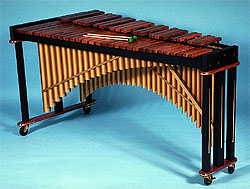
|
|
Around 1910, the marimba made its appearance in the percussion section of Western orchestras. Wooden resonators were replaced by metallic tubes that could be tuned by moving metal discs located in their lower extremity, and the mirlitons were eliminated. The frame of this marimba is made of sugar maple and kingwood, covered with black lacquer and decorated in purple and gold. Locking casters make the instrument easier to move. The tubular resonators have a gold lacquer, and the Honduran rosewood bars are finished in satin lacquer. This marimba has a range of fifty-two notes--four octaves plus a minor third. It was built specially for Opus.
Denis Grenier is one of the few North American instrument makers to specialize in percussion bar instruments. He became interested in the craft while repairing school instruments. Through hours spent dismantling and reassembling numerous instruments, he became thoroughly familiar with their construction and developed an eye for identifying their design flaws and qualities. When he received his first order, he decided to design his own prototype. As a self-taught artisan, Grenier has eagerly sought the advice of cabinetmakers, engineers and musicians. His father, a certified machinist, has also been a valuable resource person. Grenier opened his workshop in 1982 and gave up teaching percussion music in 1987 to concentrate full-time on instrument making. While most of his instruments are designed for the educational sector--post-secondary institutions, universities and conservatories--his clients also include professional percussionists from various musical ensembles. Denis Grenier has developed approximately fifty exclusive models of instruments, for which he has devised the design, acoustic calculations, and assembly procedures.
|
 |



